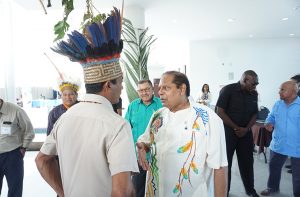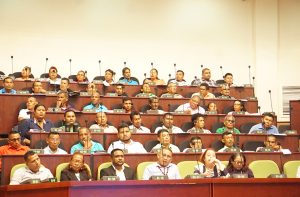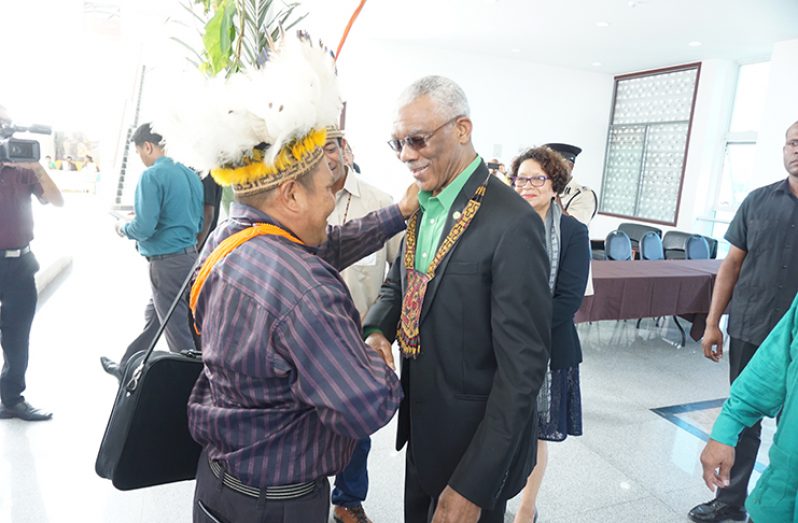…President Granger tells NTC conference opening
…says Indigenous Peoples enjoying better access to a range of public services
By Svetlana Marshall
PRESIDENT Granger, on Monday, underscored that his administration has been working to ensure human development takes place in the Hinterland, just as it occurs on the coastland, especially in the areas of education, health, livelihood and social protection.
“Indigenous peoples are enjoying better access to public education, public health, public information, public infrastructure, public security, public telecommunications and social security,” the Head of State told the opening of the National Toshaos Council conference held at the Arthur Chung Conference Centre.
This year’s NTC Conference is themed, “Guyana’s First Peoples united in the promotion of the Green Economy through preservation of our languages, lands and rights.”
He addressed the conference, comprising more than 200 Toshaos and Senior Councillors, in the presence of Prime Minister, Moses Nagamootoo; Vice President and Minister of Indigenous People’s Affairs, Sydney Allicock; Minister within the Ministry of Indigenous People’s Affairs Valerie Garrido-Lowe among other Ministers of Government. A few Opposition Members of Parliament were also present.
In the Education Sector, for which Indigenous communities benefited, $170B was injected over the last four years as part of Government’s push to bridge the gap between the Hinterland and Coastland. Billions of dollars were also pumped into the Public Health Sector resulting in greater access to health services. “Health professionals have been deployed to the hinterland to boost health-care delivery. Emergency health-care services have been improved with the addition of new water ambulances in riverine neighbourhoods – at Baracara, Karawab, Kwakwani, Moruca, Orealla and St. Monica,” President Granger pointed out.

Government, he said, is also working feverishly to raise the standard of living of Indigenous People. “Your Government has continued to narrow development gaps between the coastland and hinterland in the provision of these services. The Hinterland Sustainable Agriculture Development Programme has improved food security through the expansion of hinterland agriculture and agro-processing in the Barima-Waini, Cuyuni-Mazaruni, Potaro-Siparuni and Rupununi Regions. Hinterland farmers have benefitted from the services provided by the programme,” he further pointed out.
The Hinterland Employment Youth Service (HEYS) and the Youth Entrepreneurship and Skills Training (YEST) programme, have been stimulating jobs and entrepreneurship within indigenous communities. “Jobs are important in providing incomes for households and in diversifying and stimulating village economies. Hinterland development is about human beings, it is about people and we are on the right path. Hinterland development is advancing,” he explained.
But while there have been advancements in those critical sectors, President Granger said the country cannot ignore the fact that social ills such as alcoholism, child labour, drug abuse, sexual abuse and teenage pregnancies, remain problematic.
“The eradication of these social ills and the elimination of extreme poverty require intensified cooperation among Regional Democratic Councils, the National Toshaos’ Council, Indigenous Village Councils and Central Government, particularly through the Ministry of Indigenous Peoples’ Affairs,” President Granger told the indigenous leaders.
Nonetheless, he said his Administration has been actively working to incorporate the United Nations (UN) Sustainable Development Goals (SDGs) into national planning processes, policies and strategies. Turning to the leadership of the NTC, President Granger said it was also necessary for the Indigenous leaders to incorporate the SDGs into their 10-year Village Improvement Plans.
The Government, he iterated, will launch the Decade of Development 2020-2029 come next year. “The objectives of the ‘Decade’ will be aligned to the UN’s Sustainable Development Goals (SDGs),” he assured those present.

“The ‘Decade’ will promote measures aimed at closing the development gaps between the hinterland and coastland. It will aim at ensuring that indigenous peoples, inter alia, would not be left behind. It will seek to promote measures aimed at solving the social problems which handicap indigenous peoples and hamper human development,” he further added.
Minister Allicock, in his address, told the indigenous leaders that exciting times are ahead as he pointed to the Government’s Green State Development Strategy (GSDS) and the impending Oil and Gas Sector. He said as the country enters this new era, it is necessary for indigenous people to position themselves.
“Part of the NTC’s role is to ensure that our indigenous people benefit equally from our oil and all other natural resources, by ensuring that you help to educate, first of all yourself on the oil industry, you help to educate your people, by giving them appropriate education, so that we can have a well-rounded workforce,” Minister Allicock said.
Notwithstanding the coming of oil, the Minister said it was important for villages and their districts to develop their agricultural and tourism products.
Meanwhile, Minister Garrido-Lowe urged the indigenous leaders to use the five-day conference wisely, that is, to advance their developments while providing solutions to the problems faced by their villages. “Let us use this forum wisely, let us place our ideas for the sustainable development of our communities…We have problems, let us bring solutions to our problems, and let us place them on the table for discussion,” she urged the Toshaos and Senior Councilors. Like the President, she too alluded to the many developments in the Education, Health, Business, Social Services, Infrastructure, ICT and Agriculture Sectors that benefit indigenous people directly. The conference continues today at the convention centre.



.jpg)








